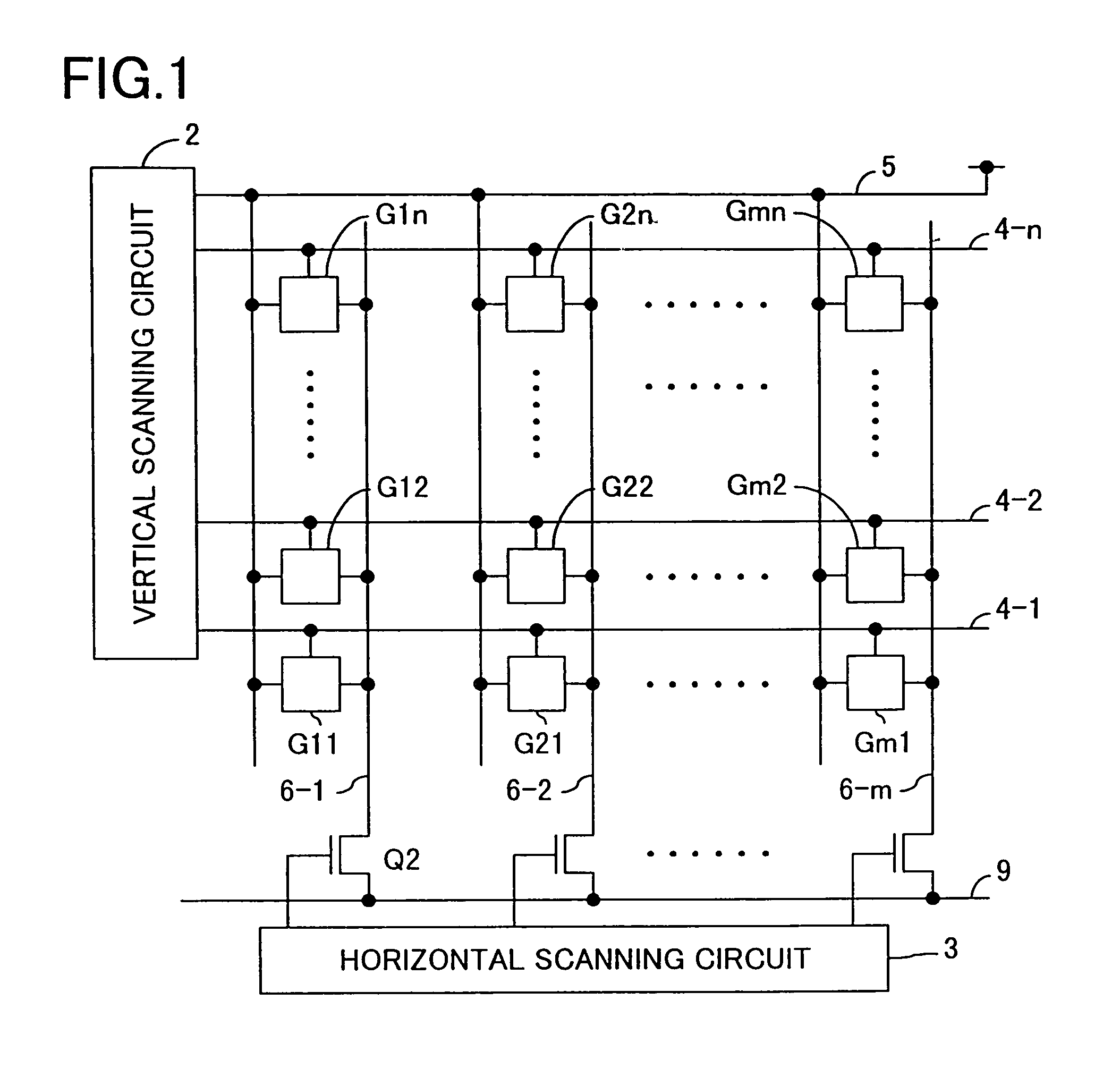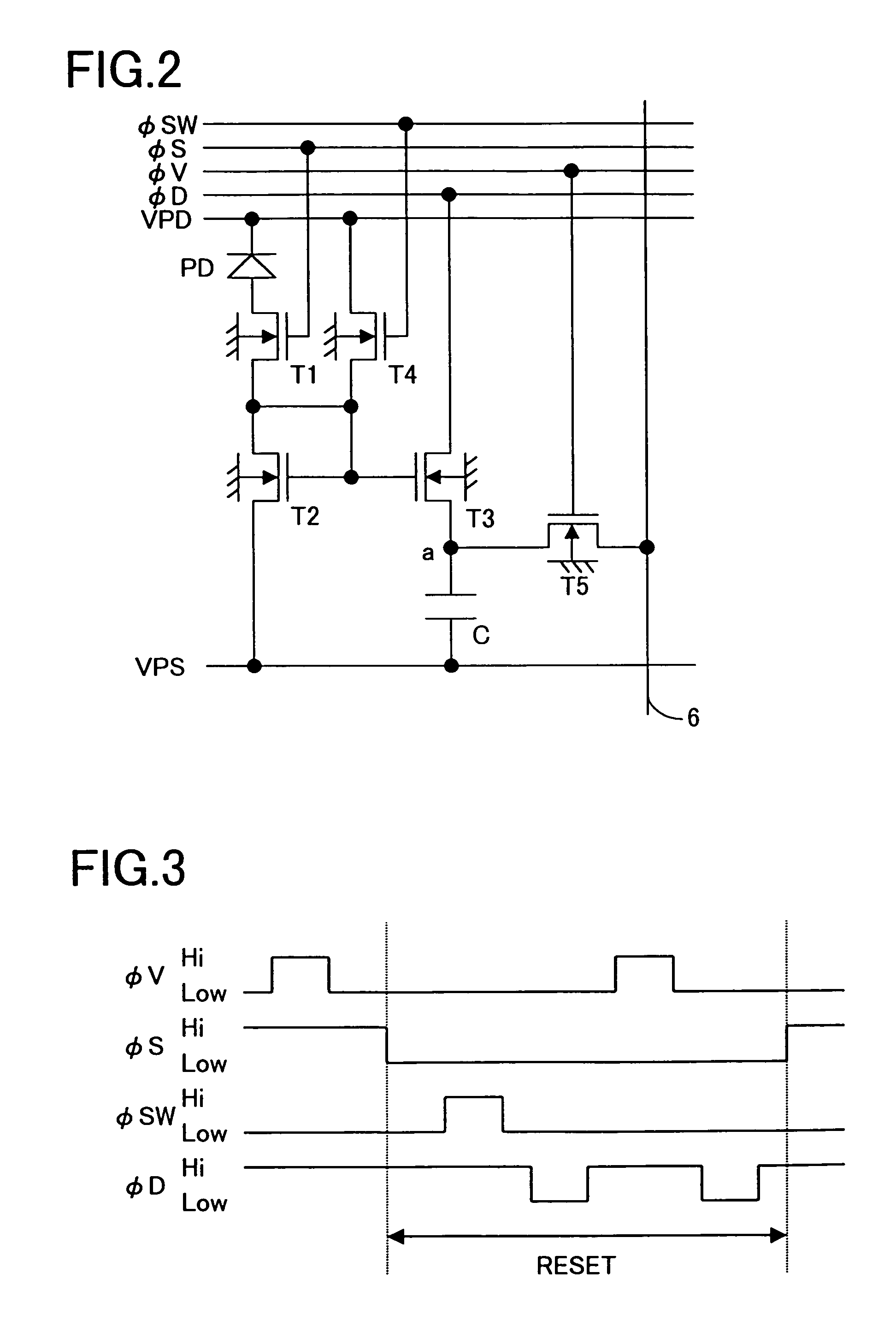Solid-state image-sensing device
a solid-state image and image-sensing technology, applied in the field of solid-state image-sensing devices, can solve the problems of narrow dynamic range, flat blackness in dim portions of obtained images, and saturation in bright portions, and achieve the effect of accurate compensation data acquisition
- Summary
- Abstract
- Description
- Claims
- Application Information
AI Technical Summary
Benefits of technology
Problems solved by technology
Method used
Image
Examples
first embodiment
[0098]A first embodiment of the invention, which is applicable to each pixel of the first example of pixel configuration shown in FIG. 1, will be described below with reference to the drawings.
[0099]In FIG. 2, a pn photodiode PD constitutes a photosensor (photoelectric converter). The anode of this photodiode PD is connected to the drain of a MOS transistor T1. The source of this MOS transistor T1 is connected to the drain and gate of a MOS transistor T2, to the gate of a MOS transistor T3, and to the source of a MOS transistor T4. The source of the MOS transistor T3 is connected to the drain of a MOS transistor T5 for row selection. The source of this MOS transistor T5 is connected to an output signal line 6 (this output signal line 6 corresponds to the output signal lines 6-1, 6-2, . . . , 6-m in FIG. 1). The MOS transistors T1 to T5 are all N-channel MOS transistors with their back gates grounded.
[0100]A direct-current voltage VPD is applied to the cathode of the photodiode PD. O...
second embodiment
[0117]A second embodiment of the invention, which is applicable to each pixel of the second example of pixel configuration shown in FIG. 5, will be described below with reference to the drawings. FIG. 7 is a circuit diagram showing the configuration of each pixel provided in the solid-state image-sensing device of this embodiment. In the following descriptions, such circuit elements, signal lines, and others as serve the same purposes as in the pixel shown in FIG. 2 are identified with the same reference numerals or symbols, and their detailed explanations will not be repeated.
[0118]As shown in FIG. 7, in this embodiment, as compared with the pixel shown in FIG. 2, a MOS transistor T6 having its gate connected to the node “a” so as to perform current amplification according to the voltage at the node “a”, a MOS transistor T5 for row selection having its drain connected to the source of the MOS transistor T6, and a MOS transistor T7 having its drain connected to the node “a” so as to...
third embodiment
[0127]A third embodiment of the invention will be described below with reference to the drawings. FIG. 9 is a circuit diagram showing the configuration of each pixel provided in the solid-state image-sensing device of this embodiment. In the following descriptions, such circuit elements, signal lines, and others as serve the same purposes as in the pixel shown in FIG. 7 are identified with the same reference numerals or symbols, and their detailed explanations will not be repeated.
[0128]As shown in FIG. 9, in this embodiment, initialization of the capacitor C and the potential at the node “a” is achieved by feeding a signal φD to the drain of the MOS transistor T3. This makes it possible to omit the MOS transistor T7 found in the previous (second) embodiment. In other respects, the pixel of this embodiment is configured in the same manner as that of the second embodiment (FIG. 7). Here, as in the first embodiment (FIG. 2), in a period in which the signal φD is at a high level, the c...
PUM
 Login to View More
Login to View More Abstract
Description
Claims
Application Information
 Login to View More
Login to View More - R&D
- Intellectual Property
- Life Sciences
- Materials
- Tech Scout
- Unparalleled Data Quality
- Higher Quality Content
- 60% Fewer Hallucinations
Browse by: Latest US Patents, China's latest patents, Technical Efficacy Thesaurus, Application Domain, Technology Topic, Popular Technical Reports.
© 2025 PatSnap. All rights reserved.Legal|Privacy policy|Modern Slavery Act Transparency Statement|Sitemap|About US| Contact US: help@patsnap.com



